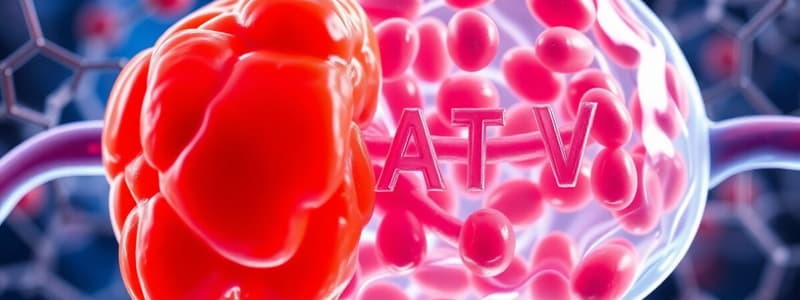Podcast
Questions and Answers
What role does biotin play in the conversion of propionyl-CoA?
What role does biotin play in the conversion of propionyl-CoA?
- It acts as a coenzyme for propionyl-CoA carboxylase. (correct)
- It converts α-ketoglutarate into oxaloacetate.
- It directly produces succinyl-CoA.
- It enhances the activity of the Krebs cycle.
Which pair of conversions is correctly matched with their corresponding Krebs cycle intermediates?
Which pair of conversions is correctly matched with their corresponding Krebs cycle intermediates?
- Isocitrate to succinate
- Glutamate to alpha-ketoglutarate (correct)
- Aspartate to succinyl-CoA
- Propionyl-CoA to oxaloacetate
How many molecules of carbon dioxide are released during the complete oxidation of one glucose molecule in the TCA cycle?
How many molecules of carbon dioxide are released during the complete oxidation of one glucose molecule in the TCA cycle?
- Four molecules
- Two molecules (correct)
- One molecule
- Three molecules
What is the primary significance of anaplerosis in cellular metabolism?
What is the primary significance of anaplerosis in cellular metabolism?
Which enzyme catalyzes the oxidative decarboxylation of isocitrate in the TCA cycle?
Which enzyme catalyzes the oxidative decarboxylation of isocitrate in the TCA cycle?
What is the net ATP yield from glycolysis when one glucose molecule is broken down anaerobically?
What is the net ATP yield from glycolysis when one glucose molecule is broken down anaerobically?
Which statement correctly describes the ATP production in aerobic respiration?
Which statement correctly describes the ATP production in aerobic respiration?
What is the role of anaplerosis in cellular metabolism?
What is the role of anaplerosis in cellular metabolism?
Which molecules are produced during the Krebs cycle from the breakdown of pyruvate?
Which molecules are produced during the Krebs cycle from the breakdown of pyruvate?
What type of reaction converts pyruvate into oxaloacetate in the Krebs cycle?
What type of reaction converts pyruvate into oxaloacetate in the Krebs cycle?
What is the primary reason for conducting anaplerotic reactions during metabolic changes?
What is the primary reason for conducting anaplerotic reactions during metabolic changes?
Which process is NOT involved in producing ATP from glucose?
Which process is NOT involved in producing ATP from glucose?
Which of the following statements about anaerobic respiration is true?
Which of the following statements about anaerobic respiration is true?
Flashcards are hidden until you start studying
Study Notes
ATP Yield in Anaerobic vs. Aerobic Respiration
- Anaerobic respiration yields 2 ATP molecules per glucose through glycolysis.
- Glycolysis converts glucose into pyruvate, producing a total of 4 ATP but netting 2 ATP due to 2 ATP consumed in the process.
- Aerobic respiration is significantly more efficient, yielding up to 38 ATP per glucose molecule.
- Aerobic processes include glycolysis, the Krebs cycle, and the electron transport chain.
- Glycolysis: produces 2 ATP from glucose breakdown.
- Krebs Cycle: produces 2 ATP, 6 NADH, and 2 FADH2 from pyruvate oxidation.
- Electron Transport Chain: converts NADH and FADH2 into 34 ATP through oxidative phosphorylation.
Anaplerosis: Replenishing the Krebs Cycle
- Anaplerosis is crucial for replenishing Krebs cycle intermediates, vital for cellular respiration.
- Intermediate depletion occurs as Krebs cycle intermediates are used in amino acids, fatty acids, and heme synthesis.
- It enhances metabolic flexibility by allowing organics to adapt to nutritional shortages.
- Anaplerotic reactions convert substrates like amino acids and fatty acids into Krebs cycle intermediates.
Common Anaplerotic Reactions
- Pyruvate Carboxylation: Converts pyruvate into oxaloacetate (Krebs cycle intermediate), requires biotin and catalyzed by pyruvate carboxylase.
- Amino Acid Transamination: Facilitates conversion of amino acids (e.g., glutamate into alpha-ketoglutarate) into intermediates.
- Propionyl-CoA Carboxylation: Converts propionyl-CoA (from fatty acid metabolism) into succinyl-CoA, requires biotin and is catalyzed by propionyl-CoA carboxylase.
Significance of Anaplerosis
- Ensures a steady supply of Krebs cycle intermediates vital for ATP generation.
- Plays a key role in metabolic regulation, adapting to varying nutritional states.
- Provides intermediates essential for synthesis of amino acids and fatty acids, critical for cell and tissue structures.
Carbon Dioxide Production in TCA Cycle
- Carbon dioxide is released during specific steps of the TCA cycle:
- Isocitrate to α-ketoglutarate: Oxidative decarboxylation catalyzed by isocitrate dehydrogenase releases 1 CO2 molecule.
- α-ketoglutarate to succinyl-CoA: Another oxidative decarboxylation by α-ketoglutarate dehydrogenase complex releases 1 CO2 molecule.
- A total of 2 CO2 molecules are liberated from the oxidation of one glucose molecule in the TCA cycle, exhaled as metabolic waste.
Studying That Suits You
Use AI to generate personalized quizzes and flashcards to suit your learning preferences.




